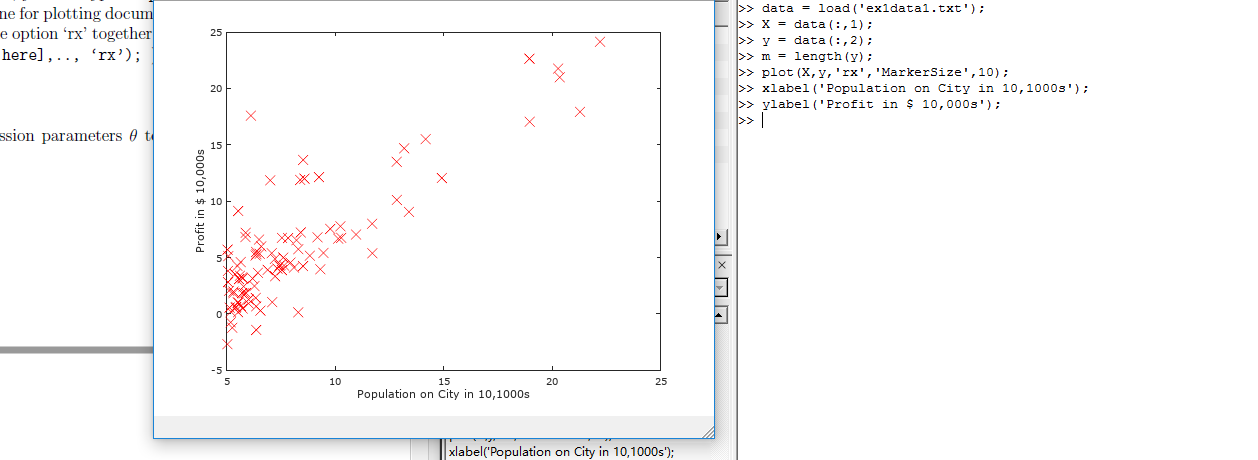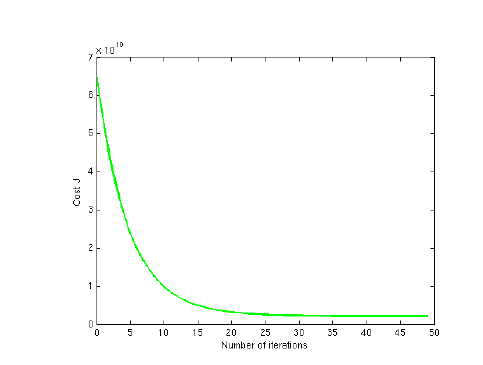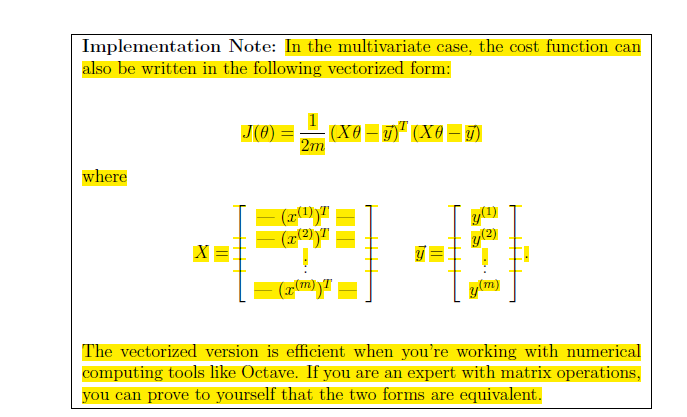【机器学习】用Octave实现一元线性回归的梯度下降算法
Step1 Plotting the Data
在处理数据之前,我们通常要了解数据,对于这次的数据集合,我们可以通过离散的点来描绘它,在一个2D的平面里把它画出来。
6.1101,17.592
5.5277,9.1302
8.5186,13.662
7.0032,11.854
5.8598,6.8233
8.3829,11.886
7.4764,4.3483
8.5781,12
6.4862,6.5987
5.0546,3.8166
5.7107,3.2522
14.164,15.505
5.734,3.1551
8.4084,7.2258
5.6407,0.71618
5.3794,3.5129
6.3654,5.3048
5.1301,0.56077
6.4296,3.6518
7.0708,5.3893
6.1891,3.1386
20.27,21.767
5.4901,4.263
6.3261,5.1875
5.5649,3.0825
18.945,22.638
12.828,13.501
10.957,7.0467
13.176,14.692
22.203,24.147
5.2524,-1.22
6.5894,5.9966
9.2482,12.134
5.8918,1.8495
8.2111,6.5426
7.9334,4.5623
8.0959,4.1164
5.6063,3.3928
12.836,10.117
6.3534,5.4974
5.4069,0.55657
6.8825,3.9115
11.708,5.3854
5.7737,2.4406
7.8247,6.7318
7.0931,1.0463
5.0702,5.1337
5.8014,1.844
11.7,8.0043
5.5416,1.0179
7.5402,6.7504
5.3077,1.8396
7.4239,4.2885
7.6031,4.9981
6.3328,1.4233
6.3589,-1.4211
6.2742,2.4756
5.6397,4.6042
9.3102,3.9624
9.4536,5.4141
8.8254,5.1694
5.1793,-0.74279
21.279,17.929
14.908,12.054
18.959,17.054
7.2182,4.8852
8.2951,5.7442
10.236,7.7754
5.4994,1.0173
20.341,20.992
10.136,6.6799
7.3345,4.0259
6.0062,1.2784
7.2259,3.3411
5.0269,-2.6807
6.5479,0.29678
7.5386,3.8845
5.0365,5.7014
10.274,6.7526
5.1077,2.0576
5.7292,0.47953
5.1884,0.20421
6.3557,0.67861
9.7687,7.5435
6.5159,5.3436
8.5172,4.2415
9.1802,6.7981
6.002,0.92695
5.5204,0.152
5.0594,2.8214
5.7077,1.8451
7.6366,4.2959
5.8707,7.2029
5.3054,1.9869
8.2934,0.14454
13.394,9.0551
5.4369,0.61705
ex1data1.txt
我们把ex1data1中的内容读取到X变量和y变量中,用m表示数据长度。
data = load('ex1data1.txt');
X = data(:,1);
y = data(:,2);
m = length(y);
接下来通过图像描绘出来。
plot(x,y,'rx','MakerSize',10);
ylabel('Profit in $10,000s');
xlabel('Population of City in 10,000s');
现在我们得到图像如图所示,就是原始的数据的直观表示。

Step2 Gradient Descent
现在,我们通过梯度下降法对参数θ进行线性回归。
依照我们之前所得出步骤方法

迭代更新
计算θ值函数:
function J = computeCost(X, y, theta)
%COMPUTECOST Compute cost for linear regression
% J = COMPUTECOST(X, y, theta) computes the cost of using theta as the
% parameter for linear regression to fit the data points in X and y % Initialize some useful values
m = length(y); % number of training examples % You need to return the following variables correctly
J = 0; % ====================== YOUR CODE HERE ======================
% Instructions: Compute the cost of a particular choice of theta
% You should set J to the cost.
J = sum((X * theta - y).^2) / (2*m); % X(79,2) theta(2,1) % ========================================================================= end
接下来是梯度下降函数
function [theta, J_history] = gradientDescent(X, y, theta, alpha, num_iters)
%GRADIENTDESCENT Performs gradient descent to learn theta
% theta = GRADIENTDESENT(X, y, theta, alpha, num_iters) updates theta by
% taking num_iters gradient steps with learning rate alpha % Initialize some useful values
m = length(y); % number of training examples
J_history = zeros(num_iters, 1);
theta_s=theta; for iter = 1:num_iters % ====================== YOUR CODE HERE ======================
% Instructions: Perform a single gradient step on the parameter vector
% theta.
%
% Hint: While debugging, it can be useful to print out the values
% of the cost function (computeCost) and gradient here.
%
theta(1) = theta(1) - alpha / m * sum(X * theta_s - y);
theta(2) = theta(2) - alpha / m * sum((X * theta_s - y) .* X(:,2));
% 必须同时更新theta(1)和theta(2),所以不能用X * theta,而要用theta_s存储上次结果。
theta_s=theta; % ============================================================ % Save the cost J in every iteration
J_history(iter) = computeCost(X, y, theta); end
J_history
end
绘图函数:
function plotData(x, y)
%PLOTDATA Plots the data points x and y into a new figure
% PLOTDATA(x,y) plots the data points and gives the figure axes labels of
% population and profit. % ====================== YOUR CODE HERE ======================
% Instructions: Plot the training data into a figure using the
% "figure" and "plot" commands. Set the axes labels using
% the "xlabel" and "ylabel" commands. Assume the
% population and revenue data have been passed in
% as the x and y arguments of this function.
%
% Hint: You can use the 'rx' option with plot to have the markers
% appear as red crosses. Furthermore, you can make the
% markers larger by using plot(..., 'rx', 'MarkerSize', 10); figure; % open a new figure window
plot(x, y, 'rx', 'MarkerSize', 10); % Plot the data
ylabel('Profit in $10,000s'); % Set the y axis label
xlabel('Population of City in 10,000s'); % Set the x axis label % ============================================================ end
根据以上函数,我们进行线性回归:
%% Machine Learning Online Class - Exercise 1: Linear Regression % Instructions
% ------------
%
% This file contains code that helps you get started on the
% linear exercise. You will need to complete the following functions
% in this exericse:
%
% warmUpExercise.m
% plotData.m
% gradientDescent.m
% computeCost.m
% gradientDescentMulti.m
% computeCostMulti.m
% featureNormalize.m
% normalEqn.m
%
% For this exercise, you will not need to change any code in this file,
% or any other files other than those mentioned above.
%
% x refers to the population size in 10,000s
% y refers to the profit in $10,000s
% %% ==================== Part 1: Basic Function ====================
% Complete warmUpExercise.m
fprintf('Running warmUpExercise ... \n');
fprintf('5x5 Identity Matrix: \n');
warmUpExercise() fprintf('Program paused. Press enter to continue.\n');
pause; %% ======================= Part 2: Plotting =======================
fprintf('Plotting Data ...\n')
data = load('ex1data1.txt');
X = data(:, 1); y = data(:, 2);
m = length(y); % number of training examples % Plot Data
% Note: You have to complete the code in plotData.m
plotData(X, y); fprintf('Program paused. Press enter to continue.\n');
pause; %% =================== Part 3: Gradient descent ===================
fprintf('Running Gradient Descent ...\n') X = [ones(m, 1), data(:,1)]; % Add a column of ones to x
theta = zeros(2, 1); % initialize fitting parameters % Some gradient descent settings
iterations = 1500;
alpha = 0.01; % compute and display initial cost
computeCost(X, y, theta) % run gradient descent
theta = gradientDescent(X, y, theta, alpha, iterations); % print theta to screen
fprintf('Theta found by gradient descent: ');
fprintf('%f %f \n', theta(1), theta(2)); % Plot the linear fit
hold on; % keep previous plot visible
plot(X(:,2), X*theta, '-')
legend('Training data', 'Linear regression')
hold off % don't overlay any more plots on this figure % Predict values for population sizes of 35,000 and 70,000
predict1 = [1, 3.5] *theta;
fprintf('For population = 35,000, we predict a profit of %f\n',...
predict1*10000);
predict2 = [1, 7] * theta;
fprintf('For population = 70,000, we predict a profit of %f\n',...
predict2*10000); fprintf('Program paused. Press enter to continue.\n');
pause; %% ============= Part 4: Visualizing J(theta_0, theta_1) =============
fprintf('Visualizing J(theta_0, theta_1) ...\n') % Grid over which we will calculate J
theta0_vals = linspace(-10, 10, 100);
theta1_vals = linspace(-1, 4, 100); % initialize J_vals to a matrix of 0's
J_vals = zeros(length(theta0_vals), length(theta1_vals)); % Fill out J_vals
for i = 1:length(theta0_vals)
for j = 1:length(theta1_vals)
t = [theta0_vals(i); theta1_vals(j)];
J_vals(i,j) = computeCost(X, y, t);
end
end % Because of the way meshgrids work in the surf command, we need to
% transpose J_vals before calling surf, or else the axes will be flipped
J_vals = J_vals';
% Surface plot
figure;
surf(theta0_vals, theta1_vals, J_vals)
xlabel('\theta_0'); ylabel('\theta_1'); % Contour plot
figure;
% Plot J_vals as 15 contours spaced logarithmically between 0.01 and 100
contour(theta0_vals, theta1_vals, J_vals, logspace(-2, 3, 20))
xlabel('\theta_0'); ylabel('\theta_1');
hold on;
plot(theta(1), theta(2), 'rx', 'MarkerSize', 10, 'LineWidth', 2);

如图所示,绘制出线性回归函数。
这时所绘制2D等高线图梯度下降表面图:
function [X_norm, mu, sigma] = featureNormalize(X)
%FEATURENORMALIZE Normalizes the features in X
% FEATURENORMALIZE(X) returns a normalized version of X where
% the mean value of each feature is 0 and the standard deviation
% is 1. This is often a good preprocessing step to do when
% working with learning algorithms. % You need to set these values correctly
X_norm = X;
mu = zeros(1, size(X, 2)); % mean value 均值 size(X,2) 列数
sigma = zeros(1, size(X, 2)); % standard deviation 标准差 % ====================== YOUR CODE HERE ======================
% Instructions: First, for each feature dimension, compute the mean
% of the feature and subtract it from the dataset,
% storing the mean value in mu. Next, compute the
% standard deviation of each feature and divide
% each feature by it's standard deviation, storing
% the standard deviation in sigma.
%
% Note that X is a matrix where each column is a
% feature and each row is an example. You need
% to perform the normalization separately for
% each feature.
%
% Hint: You might find the 'mean' and 'std' functions useful.
%
mu = mean(X); % mean value
sigma = std(X); % standard deviation
X_norm = (X - repmat(mu,size(X,1),1)) ./ repmat(sigma,size(X,1),1); % ============================================================ end
function [theta, J_history] = gradientDescentMulti(X, y, theta, alpha, num_iters)
%GRADIENTDESCENTMULTI Performs gradient descent to learn theta
% theta = GRADIENTDESCENTMULTI(x, y, theta, alpha, num_iters) updates theta by
% taking num_iters gradient steps with learning rate alpha % Initialize some useful values
m = length(y); % number of training examples
J_history = zeros(num_iters, 1); for iter = 1:num_iters % ====================== YOUR CODE HERE ======================
% Instructions: Perform a single gradient step on the parameter vector
% theta.
%
% Hint: While debugging, it can be useful to print out the values
% of the cost function (computeCostMulti) and gradient here.
%
theta = theta - alpha / m * X' * (X * theta - y); % ============================================================ % Save the cost J in every iteration
J_history(iter) = computeCostMulti(X, y, theta); end end
function J = computeCostMulti(X, y, theta)
%COMPUTECOSTMULTI Compute cost for linear regression with multiple variables
% J = COMPUTECOSTMULTI(X, y, theta) computes the cost of using theta as the
% parameter for linear regression to fit the data points in X and y % Initialize some useful values
m = length(y); % number of training examples % You need to return the following variables correctly
J = 0; % ====================== YOUR CODE HERE ======================
% Instructions: Compute the cost of a particular choice of theta
% You should set J to the cost.
J = sum((X * theta - y).^2) / (2*m); % ========================================================================= end
function [theta] = normalEqn(X, y)
%NORMALEQN Computes the closed-form solution to linear regression
% NORMALEQN(X,y) computes the closed-form solution to linear
% regression using the normal equations. theta = zeros(size(X, 2), 1); % ====================== YOUR CODE HERE ======================
% Instructions: Complete the code to compute the closed form solution
% to linear regression and put the result in theta.
% % ---------------------- Sample Solution ---------------------- theta = pinv( X' * X ) * X' * y; % ------------------------------------------------------------- % ============================================================ end
%% Machine Learning Online Class
% Exercise 1: Linear regression with multiple variables
%
% Instructions
% ------------
%
% This file contains code that helps you get started on the
% linear regression exercise.
%
% You will need to complete the following functions in this
% exericse:
%
% warmUpExercise.m
% plotData.m
% gradientDescent.m
% computeCost.m
% gradientDescentMulti.m
% computeCostMulti.m
% featureNormalize.m
% normalEqn.m
%
% For this part of the exercise, you will need to change some
% parts of the code below for various experiments (e.g., changing
% learning rates).
% %% Initialization %% ================ Part 1: Feature Normalization ================ %% Clear and Close Figures
clear ; close all; clc fprintf('Loading data ...\n'); %% Load Data
data = load('ex1data2.txt');
X = data(:, 1:2);
y = data(:, 3);
m = length(y); % Print out some data points
fprintf('First 10 examples from the dataset: \n');
fprintf(' x = [%.0f %.0f], y = %.0f \n', [X(1:10,:) y(1:10,:)]'); fprintf('Program paused. Press enter to continue.\n');
pause; % Scale features and set them to zero mean
fprintf('Normalizing Features ...\n'); [X mu sigma] = featureNormalize(X); % 均值0,标准差1 % Add intercept term to X
X = [ones(m, 1) X]; %% ================ Part 2: Gradient Descent ================ % ====================== YOUR CODE HERE ======================
% Instructions: We have provided you with the following starter
% code that runs gradient descent with a particular
% learning rate (alpha).
%
% Your task is to first make sure that your functions -
% computeCost and gradientDescent already work with
% this starter code and support multiple variables.
%
% After that, try running gradient descent with
% different values of alpha and see which one gives
% you the best result.
%
% Finally, you should complete the code at the end
% to predict the price of a 1650 sq-ft, 3 br house.
%
% Hint: By using the 'hold on' command, you can plot multiple
% graphs on the same figure.
%
% Hint: At prediction, make sure you do the same feature normalization.
% fprintf('Running gradient descent ...\n'); % Choose some alpha value
alpha = 0.01;
num_iters = 8500; % Init Theta and Run Gradient Descent
theta = zeros(3, 1);
[theta, J_history] = gradientDescentMulti(X, y, theta, alpha, num_iters); % Plot the convergence graph
figure;
plot(1:numel(J_history), J_history, '-b', 'LineWidth', 2);
xlabel('Number of iterations');
ylabel('Cost J'); % Display gradient descent's result
fprintf('Theta computed from gradient descent: \n');
fprintf(' %f \n', theta);
fprintf('\n'); % Estimate the price of a 1650 sq-ft, 3 br house
% ====================== YOUR CODE HERE ======================
% Recall that the first column of X is all-ones. Thus, it does
% not need to be normalized.
price = [1 (([1650 3]-mu) ./ sigma)] * theta ;
% ============================================================ fprintf(['Predicted price of a 1650 sq-ft, 3 br house ' ...
'(using gradient descent):\n $%f\n'], price); fprintf('Program paused. Press enter to continue.\n');
pause; %% ================ Part 3: Normal Equations ================ fprintf('Solving with normal equations...\n'); % ====================== YOUR CODE HERE ======================
% Instructions: The following code computes the closed form
% solution for linear regression using the normal
% equations. You should complete the code in
% normalEqn.m
%
% After doing so, you should complete this code
% to predict the price of a 1650 sq-ft, 3 br house.
% %% Load Data
data = csvread('ex1data2.txt');
X = data(:, 1:2);
y = data(:, 3);
m = length(y); % Add intercept term to X
X = [ones(m, 1) X]; % Calculate the parameters from the normal equation
theta = normalEqn(X, y); % Display normal equation's result
fprintf('Theta computed from the normal equations: \n');
fprintf(' %f \n', theta);
fprintf('\n'); % Estimate the price of a 1650 sq-ft, 3 br house
% ====================== YOUR CODE HERE ======================
price = [1 1650 3] * theta ; % ============================================================ fprintf(['Predicted price of a 1650 sq-ft, 3 br house ' ...
'(using normal equations):\n $%f\n'], price);
处理前:

处理后:


回归过程如图所示:

至此,我们通过梯度下降法解决了此问题,我们还可以通过之前所说的数学方法来解决,但是对于数据太大的情况(通常大于10000),我们就会通过梯度下降法来解决了

根据以上函数,我们进行线性回归:
【机器学习】用Octave实现一元线性回归的梯度下降算法的更多相关文章
- 【转载】用OCTAVE实现一元线性回归的梯度下降算法
原文地址:http://www.cnblogs.com/KID-XiaoYuan/p/7247481.html STEP1 PLOTTING THE DATA 在处理数据之前,我们通常要了解数据,对于 ...
- 机器学习算法(优化)之一:梯度下降算法、随机梯度下降(应用于线性回归、Logistic回归等等)
本文介绍了机器学习中基本的优化算法—梯度下降算法和随机梯度下降算法,以及实际应用到线性回归.Logistic回归.矩阵分解推荐算法等ML中. 梯度下降算法基本公式 常见的符号说明和损失函数 X :所有 ...
- 100天搞定机器学习|Day36用有趣的方式解释梯度下降算法
本文为3Blue1Brown神经网络课程讲解第二部分<Gradient descent, how neural networks learn >的学习笔记,观看地址:www.bilibil ...
- 斯坦福机器学习视频笔记 Week1 线性回归和梯度下降 Linear Regression and Gradient Descent
最近开始学习Coursera上的斯坦福机器学习视频,我是刚刚接触机器学习,对此比较感兴趣:准备将我的学习笔记写下来, 作为我每天学习的签到吧,也希望和各位朋友交流学习. 这一系列的博客,我会不定期的更 ...
- machine learning 之 导论 一元线性回归
整理自Andrew Ng 的 machine learnig 课程 week1. 目录: 什么是机器学习 监督学习 非监督学习 一元线性回归 模型表示 损失函数 梯度下降算法 1.什么是机器学习 Ar ...
- 梯度下降算法对比(批量下降/随机下降/mini-batch)
大规模机器学习: 线性回归的梯度下降算法:Batch gradient descent(每次更新使用全部的训练样本) 批量梯度下降算法(Batch gradient descent): 每计算一次梯度 ...
- Python实现——一元线性回归(梯度下降法)
2019/3/25 一元线性回归--梯度下降/最小二乘法_又名:一两位小数点的悲剧_ 感觉这个才是真正的重头戏,毕竟前两者都是更倾向于直接使用公式,而不是让计算机一步步去接近真相,而这个梯度下降就不一 ...
- 机器学习---用python实现最小二乘线性回归算法并用随机梯度下降法求解 (Machine Learning Least Squares Linear Regression Application SGD)
在<机器学习---线性回归(Machine Learning Linear Regression)>一文中,我们主要介绍了最小二乘线性回归算法以及简单地介绍了梯度下降法.现在,让我们来实践 ...
- 梯度下降法及一元线性回归的python实现
梯度下降法及一元线性回归的python实现 一.梯度下降法形象解释 设想我们处在一座山的半山腰的位置,现在我们需要找到一条最快的下山路径,请问应该怎么走?根据生活经验,我们会用一种十分贪心的策略,即在 ...
随机推荐
- JMeter学习(三十七)Jmeter录制手机app脚本(转载)
转载自 http://www.cnblogs.com/yangxia-test 环境准备: 1.手机 2.wifi 3.Jmeter 具体步骤: 1.启动Jmeter: 2.“测试计划”中添加“线 ...
- springboot jpa sql查询与传值
public interface ARepository extends PagingAndSortingRepository<A, APK>, JpaSpecificationExecu ...
- 第十一章 串 (b2)蛮力匹配
- 算法篇【递归2 -- N皇后问题】
问题:输入整数N,要求在N*N的棋盘上,互相不能攻击,不在同一行同一列上,切不在对角线上,输出全部方案. 输入: 4 输出: 2 4 1 3 3 1 4 2 思路: 假设在前k-1个摆好的 ...
- Bar-Code-Recognition-System Private
本设计研究EAN13条形码识别的译码技术,在基于机器视觉技术上,构建了一套条形码在线检测识别系统,系统将由以下几个部分构成:条形码图像定位与采集.计算机图像预处理.条形码图像中值滤波去噪.条码解析与识 ...
- 去7JAVA
public static void main(String args){ for(int i=1;i<100;i++){ if(i%7!=0 && i %10!=7 & ...
- android.support.v4与Android.support.v7
Android提供了android.support.v4和android.support.v7两个库,以便低版本API可以使用高版本API的功能. Fragment(碎片)类,是在Android 3. ...
- 路径打印(set以及字符串的相关操作)
题目链接 题目描述 给你一串路径,譬如: a\b\c a\d\e b\cst d\ 你把这些路径中蕴含的目录结构给画出来,子目录直接列在父目录下面,并比父目录向右缩一格,就像这样: a b ...
- C#的格式化(进制转换|位运算)
1.首先做一下知识的普及C或c Currency 货币格式D或d Decimal 十进制格式E或e Exponent 指数格式F或f Fixed point (float)固定精度格式G或g Gene ...
- Django模板如何用一个变量查找字典值
mydict = {"key1":"value1", "key2":"value2"} 在Django模板中查找字典值的 ...
